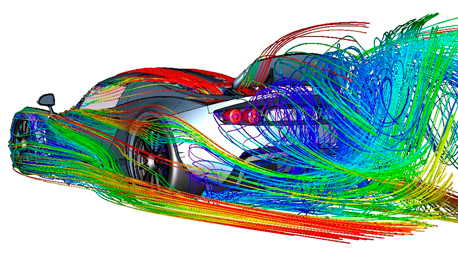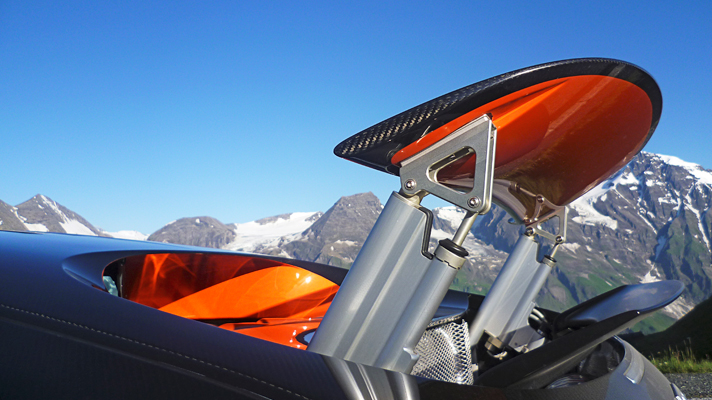
How does aero work?
Many years ago (OK, 13), when the Mk1 Lotus Exige was new, everyone was very excited that it had downforce - you know, like a racing car and all. So we set off to do a feature on it. On the road, it gripped and gripped, but then we went to a track. The lateral g was too much for me to explore, but one of our testers was a bit handy on a track, so set off down the pitlane with a cheery wave. At the first corner, he decided to throw it merrily sideways, and we all stood by to enjoy watching the rest of his lap.
No sooner had the tyres started to squeal on that first bend, he was in the gravel. The Lotus engineer who'd come along to shepherd the car turned to us spectators, shrugged his shoulders and deadpanned: "That's the trouble with wings. They only work in one direction." Once the air was no longer passing exactly fore-aft over the rear wing, it became a whole lot less effective. So the car lost rear-end grip at the exact moment our man needed it.
Road-car aerodynamics, then, are no simple matter. And they can't even be directly translated from that other brain-scramblingly complicated matter, race-car aerodynamics. We mostly tend to think only of drag and lift - or even negative lift, aka downforce. But there's a whole lot more to say. Designers have to think about the airflow that cools the powertrain, brakes and, increasingly, high-power electrical parts, too. They have to keep the glass and mirrors clean. And control noise. While maintaining practicalities like safety and space.
For most of the automobile's history, all this has behaved like a hostile, zero-sum matrix, where winning one characteristic meant losing another. But, over the past couple of decades, the science has found ways to reconcile what had been mutually exclusive aims.
Gordon Murray has designed Formula One cars with clever aero, including the Brabham BT46B ‘fan car', which remains the only F1 car with a 100per cent winning record, having caused so much uproar among rival teams it was allowed just the one outing. He did the McLaren F1, which was about the first road car with ground effect, and also used clever movable aero devices that haven't been equalled since. And he designed the T25, a car that seeks ultimate energy efficiency. But he says of the T25: "It's a city car, and aerodynamic drag doesn't really matter until you get to 40mph or so - stick your hand out of the window then, and you can feel the force on just those square inches. The faster you go after that, the more it matters." Quite so - the force of aero drag increases with the square of speed, and so the required power to overcome it rises with the cube of speed.
Once it had got itself autobahns, Germany had acquired speed. And so, in the Thirties, the value of cutting drag became clear. Paul Jaray used his aeronautics background to design a series of streamliners for Maybach, Audi and others, culminating in the Tatra T77, which had a Cd of 0.21- pretty staggering even today. He also designed a small Tatra V570, which influenced the VW Beetle. The rear engine of the Tatras meant it made sense to have the long-tail design of your stereotypical low-drag shape, the teardrop. The opposite, the usual boxy pre-war front-engined cars, were often lower in drag going backwards than forwards.
So, it was reputed, was the early, spoiler-free Porsche 928 of 1976. The American TV show Mythbusters experimented by hacking off the body and actually building a rearward-facing 928. Itwas more draggy than the original, so they figured they'd busted the myth. But I'd say they hadn't, because they still had the underside of the car going in the normal direction.
And underbody aero is crucial in cutting drag, and has been vastly underestimated until recently. Or, at least, misunderstood. That's why from the Seventies onwards - see the hilarious BMW 3.0 CSL - go-faster merchants simply riveted a huge air dam onto the front of the car to keep the pesky air from getting under there at all. Air gets turned hugely draggy and turbulent as it wends its way around the bottom of the engine, the suspension, exhaust and so on.
You can't even use a conventional wind tunnel to investigate it. You need a tunnel where the floor is a giant conveyor belt, and the car stands on it with wheels turning. In the real world, the car is moving, but the road is not - and the air isn't, either, until the car arrives to disturb it. In a moving-floor tunnel (Murray built one of the first of them while at Brabham), the air and the floor move but the car stays still, so the relative motions are the same.
Top Gear
Newsletter
Thank you for subscribing to our newsletter. Look out for your regular round-up of news, reviews and offers in your inbox.
Get all the latest news, reviews and exclusives, direct to your inbox.
Next year's Ford Mondeo tackles the underfloor issue by, in effect, putting a bandage on it. Under the whole length of the car are uninterrupted flat shielding panels. Adrian Whittle, chief engineer on the Mondeo, says that while they used to keep air out of the underside: "We now want as much air under there as possible, because once you've got a shield the drag is tiny. It also improves stability - in the past, you had the asymmetric transmission and exhaust, and so on." There's now more drag reduction because it promotes a ‘clean' - less turbulent - departure of air from the tail of the car. And it cuts underbody wind noise, too. "Mind you," says Whittle, "that shield costs proper money - in materials and in development.
"The aerodynamicist who worked on the Mondeo actually used to work on the space shuttle," grins Whittle. The car is 10 per cent lower in drag than the current one. Its other win is active shutters inside the grille - the radiator is blocked off except when it's needed, which cuts out a whole lot of turbulent flow inside the engine bay. On most cars, that air then vents itself inside the wheelarches, causing more drag and lift. BMW was among the first with these shutters, as part of the EfficientDynamics initiative. But it helps when you design a car around them as, says Whittle: "It changes the whole airflow." Detail matters, too: "Moving the mirrors to the doors and spending ages reshaping them got their drag contribution down from 0.15 to 0.09."
It's often the details that matter. To get the diesel version of the new Honda Civic down to its 110g/km target, Honda added two features denied the petrol: radiator shutters and, on each side of the car below the tail-lamps, a tiny glued-on plastic fillet that tidies up the separation of air from the car. Not pretty, but effective. Reminds me of the little ‘ears' that were fitted behind the rear side windows of the jelly-mould Ford Sierra hatch part-way through its life - they did the same job and helped stability, too.
On hybrids and EVs there's an obsessive need to cut resistance and hence energy use. The Chevy Volt gained seven miles of electric range because of aero optimisation between concept and production. And, if you think the Audi A2, Prius, Insight, Volt, etc., all look the same, with their arched roofs and high, cut-off tails, that's why. Thank Wunibald Kamm, working in Stuttgart in the Thirties, for the realisation that if a tapered, teardrop shape is abruptly cut-off, the air will separate cleanly. So a low-drag car doesn't need several feet of needle-sharp tail aft of the back wheels. Kamm tails are why parking a low-drag car needn't be a killer.
BMW's super-eco i8 begins with a low silhouette and thin wheels to cut frontal area (total drag is Cd times area, which is why tall or wide cars are never truly low-drag), and it has an enclosed underbody. Then it gets radical, with ‘layering'. Air is ducted from ahead of the wheels into tall, thin channels that jet it past each wheel as a vertical ‘air curtain', minimising turbulence. The BMW i8 also has flying buttresses over the rear three-quarters. We first saw them on the Ferrari 599, and they turned up on the Honda NSX concept, too. They're spoilers that stand proud of the car, starting at the sides of the roof and running down towards the rear lights. Credit them to Jason Castriota, who designed the 599 and then put them on his Saab PhoeniX concept. "At Ferrari, I spent a lot of time with the wind-tunnel engineers, and, at the time, their Formula One cars had all sorts of winglets and leaf-like structures to control airflow, direct it and clean it up." The buttresses compress air at their front edge, then have an expanding section that lowers the pressure, reducing thecar's lift without costing much drag. It's the same principle as a rear diffuser.
Castriota likes the i8. "It's a courageous, radical aesthetic, and says a lot about what the company is about." He reckons it's easy to do a classically beautiful design, and easy to do one that conforms to clichéd ideas of what's aerodynamic - "the shape of a bullet". But the winning designers, he believes, will be the ones who use new aero developments to make something distinctive and "push the boundaries of what people will accept aesthetically". It happened back in 1984, he points out, when Ferrari put the radiators on the side of the Testarossa, along with huge side air intakes. Revolutionary then; normal on a supercar now.
Ah, yes, radiators. If cooling is tricky on a Mondeo, consider how much harder it is on a Bugatti Veyron, with its 10 radiators for different systems. Airflow inside the car - and the eddies where hot and cool air meet - matter almost as much as flow around the outside. The rear spoiler doesn't only go up for downforce in corners, it snuggles halfway down to cut drag for high speeds, goes right up for braking, and finallylifts to let hot air out of the engine bay.
Downforce, as we saw with that Exige, is tricky on a road car. It certainly can add grip - it pushes the tyre down without adding greatly to the car's mass, so the centrifugal and braking forces rise. But because it fades away as the car slows, an F1 driver has to cope with having 5g of braking force at 200mph, and only 1.5g three seconds later at the entry to a slow corner. Could you or I feather the pedal to make that work? Could we cope with a car that had significantly different grip depending on the wind direction? Nope. So, with most road cars, the aim is to have no lift, or slight downforce, but, most importantly, to maintain it in all conditions.
That's no picnic. Supercars tend to have sealed underbodies, shaped into a venturi and diffuser - that shaping is hard to package around the boot, spare wheel and exhaust of a mass-made car. This solution is more elegant and less prone to crosswinds or sideways travel than a honking rear wing. But, as Murray explains, when you brake, the front end dives and the rear rises, which pits the narrowest part of the venturi closer to the nose. So nose downforce rises and tail downforce falls - the centre of pressure moves forward. The opposite of what you want.
Pagani has designed the Huayra with four moving wings to control the centre of pressure. Murray's F1, shaped with another designer and keen aerodynamicist, Peter Stevens, has a little fan to extract air from under the car and blow it past hot electronics and engine, to exit through carefully found locations at the rear. It improves the venturi effect, helps to keep the centre of pressure constant in pitch, lowers the drag and does vital cooling work. The F1 also has a small rear spoiler that pops up under heavy braking. Murray says those two things are so effective that the F1 actually squats its tail in high-speed braking: "It feels weird."
The F1 doesn't look like a conspicuously fancy-aero car, but it is. Truth is, aero goodness depends not so much on what a car looks like to the untrained eye, but on how the details, many of them hidden, work together. That tends to mean not just computer modelling but near-endless tunnel testing. At the Detroit show, I asked Honda designer Jon Ikeda about the aero on his NSX Concept. He said it hadn't been tested yet: "It's got stylists' aerodynamics, and that usually doesn't work." Adrian Whittle says of the Mondeo: "We spent so much time with the stylists in the tunnel. Aerodynamics really is a black art. The only person who actually understands it is Adrian Newey."
This feature was first published in the February 2012 issue of Top Gear magazine
Trending this week
- Car Review
BMW 1 Series









